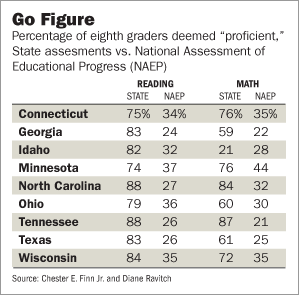
Chester Finn, Jr. and Diane Ravitch:
U.S. students lag behind their peers in other modern nations — and the gap widens dramatically as their grade levels rise. Our high school pupils (and graduates) are miles from where they need to be to assure them and our country a secure future in the highly competitive global economy. Hence, any serious effort at education reform hinges on our setting world-class standards, then candidly tracking performance in relation to those standards. Even when gains are slender and results disappointing, we need the plain truth. Which is why recent attempts by federal and state governments to sugarcoat the performance of students is so alarming.
NAEP vs. State test scores was discussed during the recent math forum.
This may be true, that we are playing with our tests and our cut-scores to make it look like our students are improving, even as they fall further behind on the international scene. But hey, folks, stop being so gosh darn negative. We are, after all, quickly achieving our overarching goal of having everyone perform the same. And we will not cease in our efforts until we have achieved that goal. In the words of current BOE candidate Arlene Silveira, “The board cannot be proud of the district’s progress until all groups of students achieve equal success in all academic disciplines throughout their school careers” (WSJ column, sometime in January). Can any of you suggest a more laudable, heart-warming goal for us to embrace?
Then again, can any of you say “Camazotz?” For those who don’t recall, that’s the scary place in “A Wrinkle in Time” where Meg and Charles Wallace Murray have to go in order to rescue their father. Remember the scene when they arrive in Camazotz, when they see all of the children bouncing identical balls in the very same rhythm? (I think they had all just taken “Physical Education 9” at Camazotz High.) What I want to know is “Is the Doyle Building really CENTRAL Central Intelligence? If so, who is IT? And most importantly, who will win in the end of our local version of the story, the Black Thing? Or Love? And where the *&%#$^% are Mrs. Whatsit, Mrs. Who, and Mrs. Which?”
On a more serious note, I would like to ask Candidate Silveira to clarify what she meant by that statement in her WSJ op ed column. She and I spoke very briefly about it after the Madison United for Academic Excellence candidates forum, but not nearly long enough for me to understand her intent or her vision in this area. Arlene, would you be so kind? Thanks. Maya, Juan and Lucy, feel free to chime in.
(And returning to a more playful one, I’d like to point out that Meg, Charles Wallace and Calvin were all academically gifted students — though clearly Calvin was also poor and had no parental support at home — and that it was these brainiacs who saved the day. “I love you, Charles Wallace!”)
With respect to the NAEP, it’s important to remember that the proficiency cut for the NAEP is very high. There was an attempt in 1998 to link the 1996 NAEP with the 1995 international TIMSS and the estimated “NAEP” results from comparison countries weren’t that impressive.
See http://nces.ed.gov/pubs98/98500.pdf“>http://nces.ed.gov/pubs98/98500.pdf.”>http://nces.ed.gov/pubs98/98500.pdf It is a large document.
Both the NAEP and the TIMSS assessed a sample of the student populations, not the entire population. Also, while the methodology for the comparison makes sense, the results should still be used with caution. And the data is ten years old.
In my opinion, however, the study underscores how much of a gold standard (maybe platinum?) “proficiency” on the NAEP is. Getting more students to NAEP proficiency levels is something we should be striving for in public education, but it is a very challenging goal.